
Divine Feminine
Divine Feminine has been at the root of my work since its inception. From my earliest works, expressions of goddess energy were abundant in my art. The divine feminine first emerged in my work as representations of females bodies mirroring those of my own family. Within this, I connected with representations of the orishas, creating works that came to be popular for their resonance with many women, my paintings Yemaya and Ochun being among the most popular. Also prevalent in my work are images of ancestors, lost loved ones and national heroes as ancestors whose fierce presence is a guiding force in my own and so many lives and paths. Figures like Julia de Burgos and Lolita Lebrón most come to mind as figures that I have painted various times. Working with revolutionary figures, I have explored concepts around feminisms, expected and imposed gender roles versus the transcendent fierceness of revolutionary women and of varied expressions of femininity. Also explored, as a woman who has birthed at home twice and whose feminine lineage includes birthworkers, are reflections on birthing and our Indigenous fertility mother, Atabey. Throughout these and all of my work is a common theme of water as symbolic element of fertility and femininity.
Scroll past the thumbnails for images with captions.



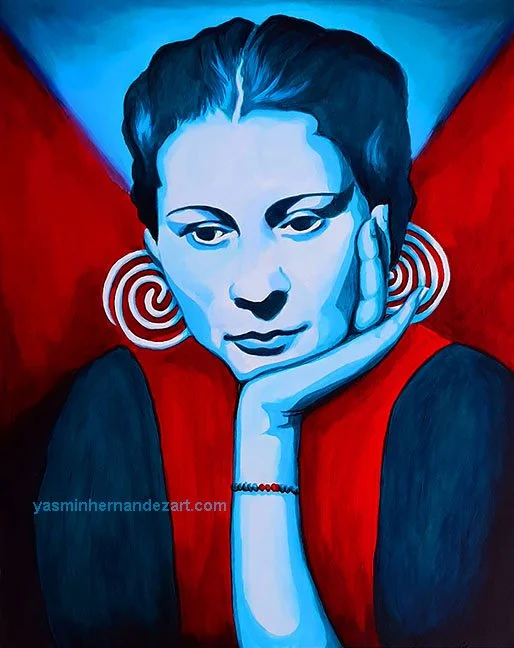
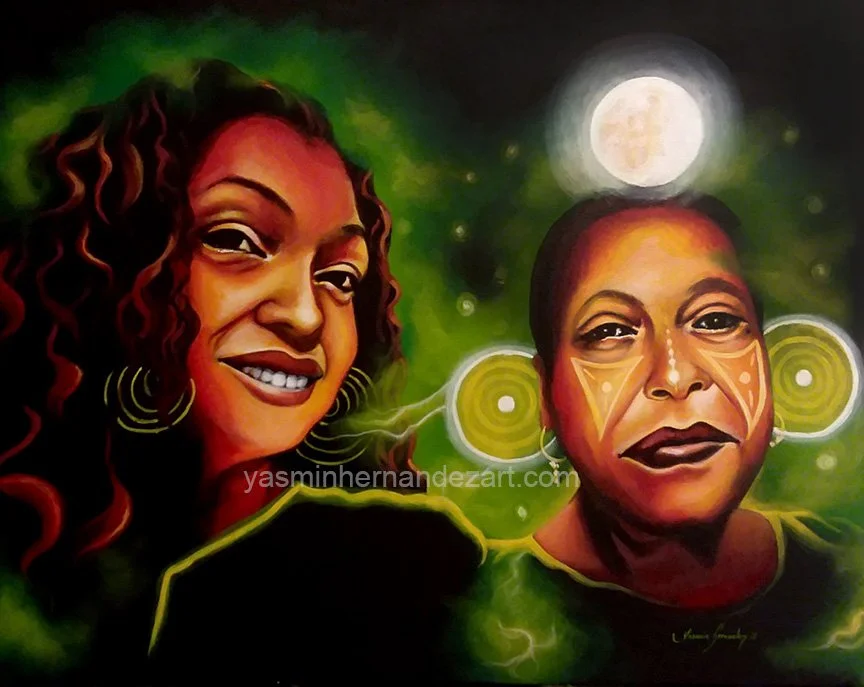
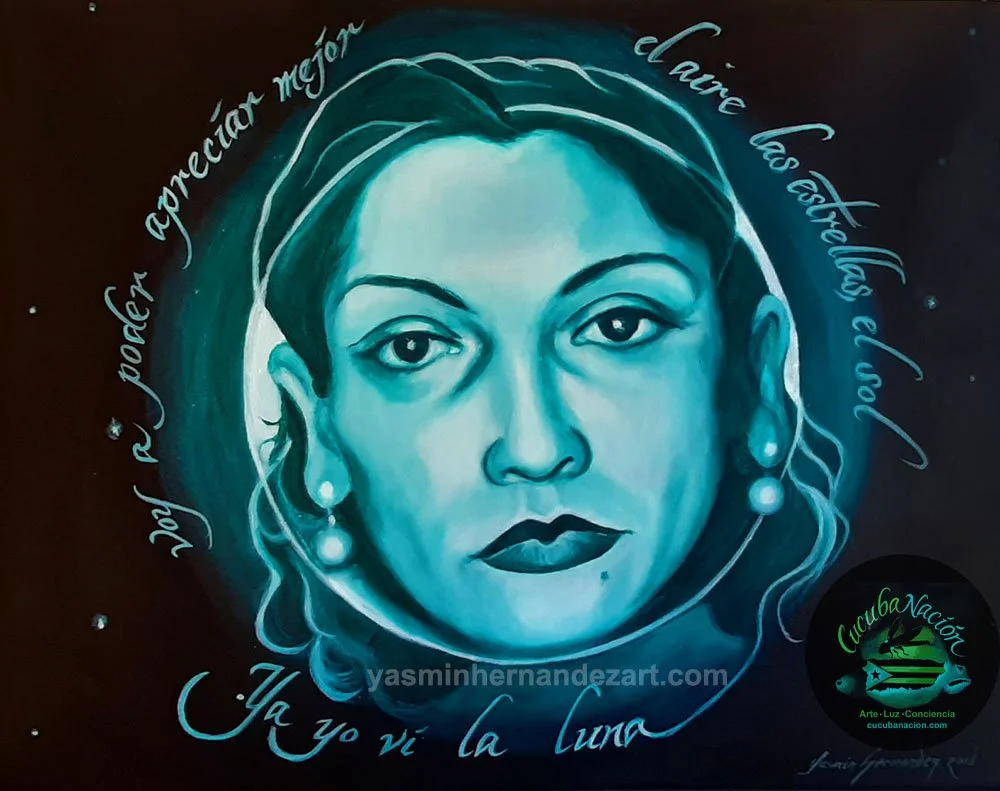





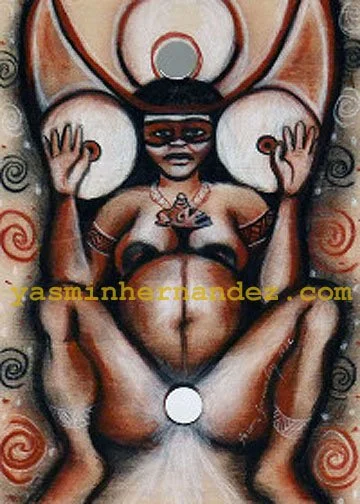


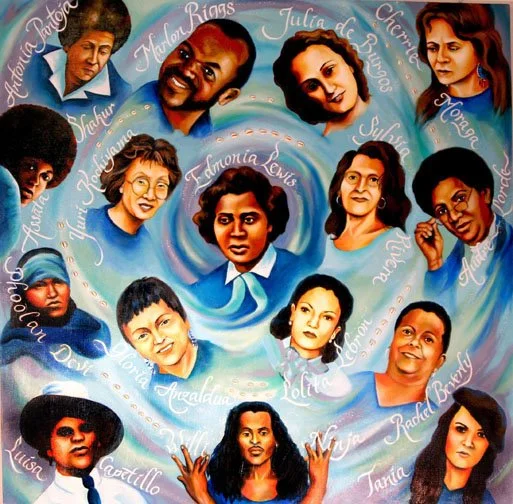


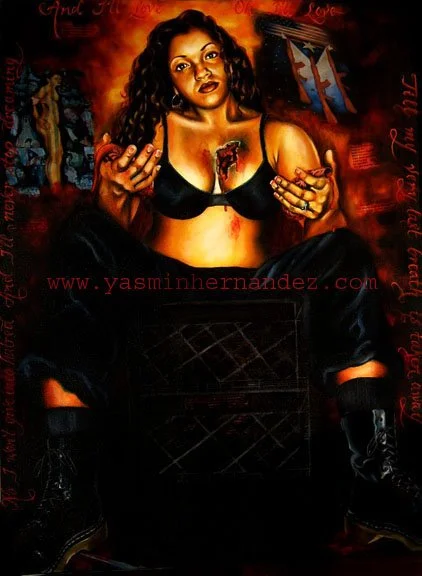


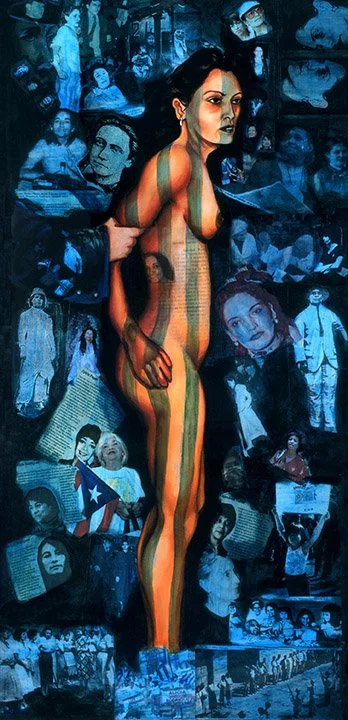

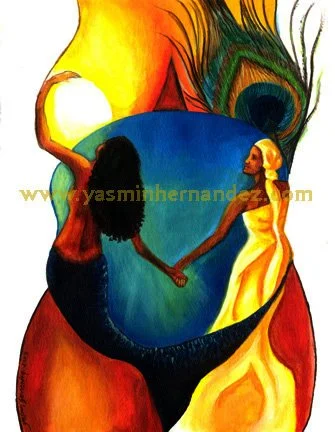

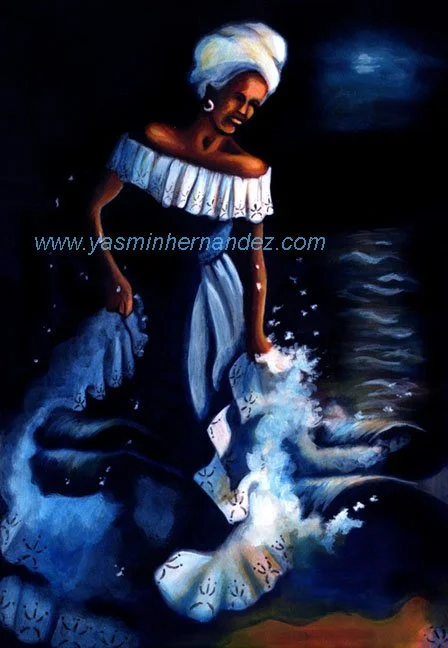

"Luisa Cósmica" 2022. Acrylic on canvas, 36 x 24 inches. "Existirá el libre cambio pues estarán abolidas las fronteras y la verdadera Libertad reinará en este planeta. Procura tu ayudar con la práctica a la realización de estas..." (Free exchange would exist as borders would be abolished and true liberation would reign on this planet. Seek to help with the practice of realizing these...) Luisa Capetillo was a Puerto Rican labor organizer, writer, activist, anarchist and espiritista. She wrote Puerto Rico's first feminist text in 1911, Mi Opinion sobre las libertades, derechos y deberes de la mujer. History most remembers her for wearing pants and being arrested for doing so but the depths and breadth of her writing, which was eons before its time, is her greatest achievement.

For International Women’s Day I completed this work, titled just as I saw it: “I Saw Alexa in a Bioluminescent Boricua Blue Heaven of Sylvia Rivera Salvation” 2020, Acrylic on Canvas, 18x24, Distraught by the news of Alexa’s murder here in Puerto Rico, I decided to sit, meditate, offer light in any way I could. Then I saw it. I saw bad ass, fierce Boricua goddess/ Stonewall Warrior Sylvia Rivera receiving Alexa on the other side. The bioluminescent waters of our magical homelands, of our ancestors, our cemies and orishas, healing, welcoming, illuminating. A young, murdered transwoman, arriving to the spirit of a trans human rights activist: fierce, protecting, inspiring. Each of Boricua blood, representing each side of el charco, its fluid, collective wisdom surrounding them, healing them. This is what we all must channel. The binary, like the two sides of el charco, are divisive. El charco calls us to embrace the power of fluidity, wherein lies the healing, liberatory power of collective wisdom and transcendent womanhood.

"Amante de la libertad (Nina Droz Franco)" 2019, acrylic on canvas, 24”x18.” Portrait of the recently released Puerto Rican political prisoner Nina Droz Franco, as a firefly channeling the warrior spirit of the indigenous ancestors of these lands. Nina was arrested at the protests against the colonial debt and severe austerity measures on May Day 2017.

"Julia de Burgos reflexiona," 2020 Commissioned for the Women's Empowerment Draft of Art Force Five, Alfred University, Alfred, NY. Portrait of Puerto Rican Poet Julia de Burgos was reproduced on trading cards and jerseys as part of a tribute to a series of powerful women. Acrylic on board 20 x 16 inches See link below for details.

"La luz que me alumbra" 2019 (The light that illuminates me) Acylic on canvas, 24" x 30" In this self-portrait with my mother I consider the glow of fireflies in the same way I work with nebulas to represent spirit energy. Thinking to myself that I needed a title for this piece, a few minutes later the song I was listening to, “Soy Canastero”, a bulería by Diego Cigala sang “tu eres la luz que me alumbra” (you are the light that illuminates me). The green glow then represents a synergy between my mother’s and my own spirit energy and how we use this light to fuel and lift one another. I painted my mother in a form inspired by Taíno mother goddess Atabey.

"Ya yo vi la luna" 2019, Acrylic on canvas, 14 x 18” I started this piece on March 1st, 2018, when the full moon coincided with the anniversary of the mission Lolita Lebron led in Washington that date in 1954 to protest US colonialism in Puerto Rico. Lolita served 25 years is US federal prisons as a result. I didn’t finish the piece until November 2019 when we commemorated the centennial of Lolita’s birth. It includes a quote from Lolita's interview with Dr. Consuelo Martinez-Reyes. “Ya yo vi la luna: la última entrevista a Lolita Lebrón." Contemplating her transition at over 90 years old she said “I will be able to better appreciate the air, the stars, the sun. I have already seen the moon.

"Hermandad Bioluminiscente" (Julia de Burgos y Consuelo) 2018. Acrylic on Canvas. 30"x24". This portrait of legendary Puerto Rican poet Julia de Burgos (on the right) and her sister Consuelo chronicles their love across waters with excerpts of letters Julia would write to Consuelo and of her poems. “Looking at you is seeing myself whole in light, rolling in blue.” Their inter-ocean sisterhood between New York and Puerto Rico reminds me of my own experience having most of my family in New York or Jersey while I am in Puerto Rico, and of the many families of the Caribbean islands and coastal communities displaced by the storms.

"Las Maravillosas Huerteritas," 2018 Acrylic on black fabric 8' x 4' Lyric excerpts by Digable Planets (I’m interplanetary/ My insect movements vary.... Peace be the greeting of the insect tribe). El Maravillos Huerto de los Niños (The Wonderful Children’s Garden) was started by my friend Lin Benitez in Vega Baja, Puerto Rico after her community experienced seven months of no lights following the storms. Their school was used as a shelter, so for many months the children roamed bored around the community. Lin manages the collection of donated tools and seeds from various sources and leads the children in the planting and harvest of herbs, fruits and vegetables with the children. The lyrics from Digable Planets speak to the transcendence and love ethic they found inspired by insects, which I use as a metaphor here for the work in this community.

"Atabex Karaya", 2014. Acrylic on navy fabric, approx 70" x 45". Atabex is the Taíno fertility goddess. Karaya is Arawak for the moon. This life-like Atabex, who loses the anthropomorphic frog legs of the traditional image to appear more like a woman birthing is associated with the moon and also Yoruba fertility & motherhood goddesses Yemaya & Ochun. From her birth canal emerges light for the spanish term for birthing: dar a luz.

"Black Gold of the Sun" 2014 2014, Acrylic on canvas, 36" x 18". Self-portrait representing my 1st pregnancy. The image is inspired by the sun and references the lower three chakras (groundedness, seat of emotions, personal power) for the lessons I embodied during that first pregnancy and home birth. The title is taken from the 1970s song by Rotary Connection.

"Nacimiento" 2013. Digital Montage on paper, 18" x 12". This image is of the moment that my midwife Sakina O'Uhuru placed my second son Josef in my arms after I birthed him in our bedroom. His dad & brother look on. I describe the physical & spiritual intensity of my sons' births as my having had to go out into the universe to get their spirits and bring them back. That is what I depict in this image with Josef and I out in the nebula.

"Atabex Natural" 2012. Charcoal, conte crayon and mirror discs on wood panel. 7" x 5". Atabex is the Taíno fertility goddess. She is surrounded by spiral representing water and fertility. Circles with a dot in the center, as seen in her headdress represent the naval/ the source and evidence of life and alternately represent polaris our skies. Over her vagina is a mirror disc to attract light, as a reference to the spanish term for birthing: dar a luz.

"Soldaderas" 2011. Outdoor Mural, Modesto "Tín" Flores Community Garden, 105th Street and Lexington Avenue, El Barrio East Harlem. Approx, 10 x 20 feet. Soldaderas, named after the women soldiers of the Mexican Revolution, is a mural tribute to Mexican painter Frida Kahlo and Puerto Rican poet Julia de Burgos. It honors the common histories/ struggles, and solidarity of Mexicans/ Chicanx and Puerto Ricans. Inspired by Kahlo’s painting, “Las dos Fridas,” the two women sit holding hands, their flags merge sharing a central red stripe. Soldaderas is also inspired by the neighboring Puerto Rican and Mexican communities who have made El Barrio/ East Harlem their home.

"Cemí" 2009. Acrylic & copper pigment on black fabric. 20" x 30". I created this piece out of frustration of having reached almost 2 weeks past my "due date". In NY it meant I wouldn't be able to birth at home. I wrote a letter to my son asking him to be born and created this painting using a women's pregnant body to represent the male fertility figure of a Taíno 3-pointer cemí. The spirals & concentric circles represent fertility and water. I went into labor the next day.

Commissioned by the Edmonia Lewis Center for Women and Transgendered People, Oberlin College, Oberlin, Ohio. Acrylic on canvas, 8' x 8'. Mothers of the motherless envisions various women, queer and trans leaders who "mothered" various communities with their activism, protection, love and nurturing. They are arranged within a whirlpool of Yemaya's waters. Featured alongside their names and swirling formations of cowrie shells adhered to the canvas. In the center is artist Edmonia Lewis.

"Ayi lo da" (Oya), 2006,Mixed media on canvas, 36" x 24", The Woman who Changes Things/ Oya Yansa, Queen of the Nine is the Yoruba warrior orisha of change, owner of the winds, the tornado, lightning and the 9 tributaries of the Niger River. Her color is purple or 9 different colors associated with the eggun, the dead. Her machete cuts through the air as her weapon. In the background is a collage of global revolutionary women of color. This image appears on the cover of Women Warriors of the Afro-Latina Diaspora.

"Jíbara Julia" 2006, Soul Rebels. Acrylic on burlap, 84" x 39". Portrait of the legendary Puerto Rican poet Julia de Burgos (2014-1953). This image depicts her as the liberator she described in her poetry. Featured in calligraphy is an excerpt from her poem Pentacromia: "Seria un obrero picando la caña/ sudando el jornal/ A brazos arriba/ los puños en alto/ quitandole al mundo mi parte de pan. (I'd be a laborer cutting cane, sweating the wage, arms up, fists high, taking from the world my piece of bread.)

"Querer ser libre (Dylcia Pagán)" 2006 2006, Acrylic, seashells and peacock feathers on canvas. 24" x 36". Portrait of my dear friend and mentor, former Puerto Rican political prisoner Dylcia Pagán as I remembered her during an afternoon we spent at the sea, behind her home in Loíza, Puerto Rico. The quote is of Ramon Emeterio Betances, (The desire to be free is to begin being free)

"Self Portrait After Frida," 2005. Mixed media on canvas 40" x 30". Prior to my Soldaderas mural, I had always admired Frida Kahlo's painting Las dos Fridas. In my self-portrait after Frida, I cut my heart out and divide it in two parts. In the background are lyrics from "Black Flowers", by Fishbone: "No I won't give in to hatred and I'll never stop dreaming/ and I'll love, oh I'll love till my very last breath is taken away. The colors red & black are a reference to Yoruba Orisha Eshu and the crossroads.

"Pesar y orgullo de la revolucionaria" 2004, Mixed media on canvas, 48" x 24". This portrait of Puerto Rican Nationalist Lolita Lebron shows her at the time of her arrest having led an armed protest at the US Capitol on March 1, 1954. She is nude with prison bars glazed over her flesh, marking the double standard imposed on women revolutionaries and the violation of their bodies as political prisoners. The collage features revolutionary women of color. This piece was in response to the 2004 Washington Post Magazine article with Lolita’s image on the cover and the title: When Terror Wore Lipstick. I was asked to contribute artwork to that article. I asked for assurance that she would not be presented in a negative light then was mortified when it was published with that cover. In a public chat with the author, people criticized Lolita for abandoning her children, making references to domestic responsibilities that male revolutionaries are never challenged on. With this work, I contemplated her body as a cell, a site of oppression that the empire wages violence on.

"Mamita," 2004, Mixed media on canvas, 36" x 18". This portrait honors my mother in law after she passed from cancer. I created the image after a favorite 1970s family snapshot of her. Her figure appears over a collage of family photos glazed in the colors of her colombian flag. Since she was very Catholic, all of her photos & that of other relatives who have passed have halos. Like the sacred heart, an image of her & her first-born son who passed appear on her chest, marking their reunion.

"Miel de abeja (Para Ochun)" 2003, Acrylic & peacock feathers on canvas, 30" x 24". Miel de abeja, honey is an offering for the Yoruba goddess of sweetness and love, Oshun. Honey is what inspired the palette for this image of Oshun in a river of sweet water, colored by the earth. Her crown is made of real peacock feathers.

"Yemaya y Ochun," 2003 2003 Acrylic on Watercolor 15" x 11" Collection of Liliana Polo Commissioned by El Diario/ La Prensa for their 2003 Women's Month Distinguished Latinas celebration. I was selected as an honoree the following year, 2004. This image honors women through the solidarity of sister orishas of femininity, motherhood, fertility and love, Yemaya & Ochun, within a women's torso.

"Yemaya Asesu," 1999, Oil on canvas, 30" x 24" This was my first portrait of Yemaya, created in the underpainting/ glaze technique. I titled it Yemaya Asesu as it was created as a gift for my cousin, and that is the aspect of Yemaya that he has crowned. Here she is seen as rising from the foam of crashing waves. Yemaya as the ocean is connected to the moon. This is why the image is set at night with the full moon.

"Yemaya" 2000. Oil on canvas, 4' x 3'. This painting of Yemaya is responsible for the majority of cyber communications & inquiries I receive regarding my art. Many folks are drawn to this image as they are drawn to the ocean & its mysteries. Yemaya is the Yoruba goddess of motherhood & the ocean. I painted this in gratitude for a spectacular sea experience during my honeymoon in Tortola, Virgin Islands. I painted this 7 years before being marked a child of Yemaya. I am ever grateful for her blessings!